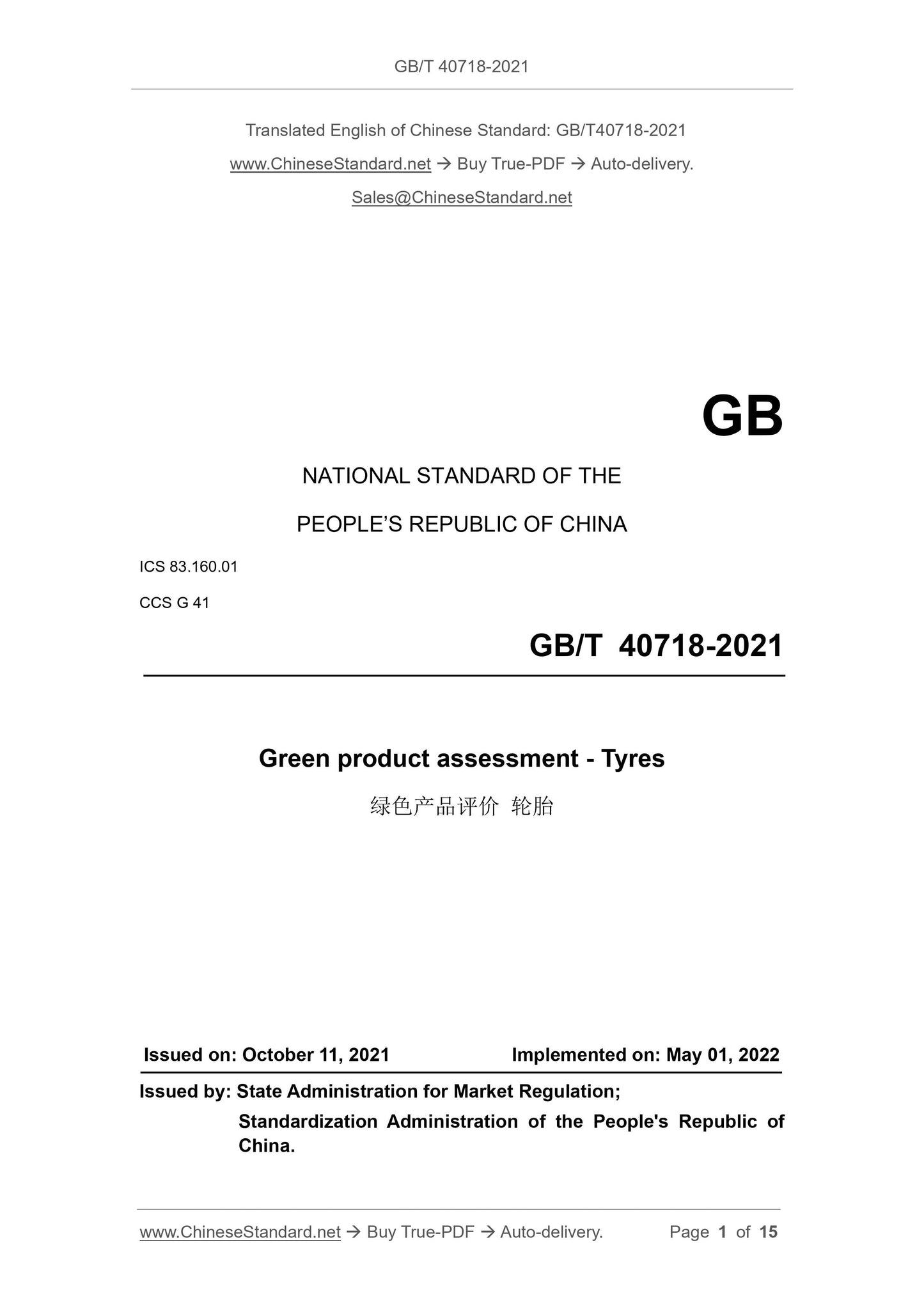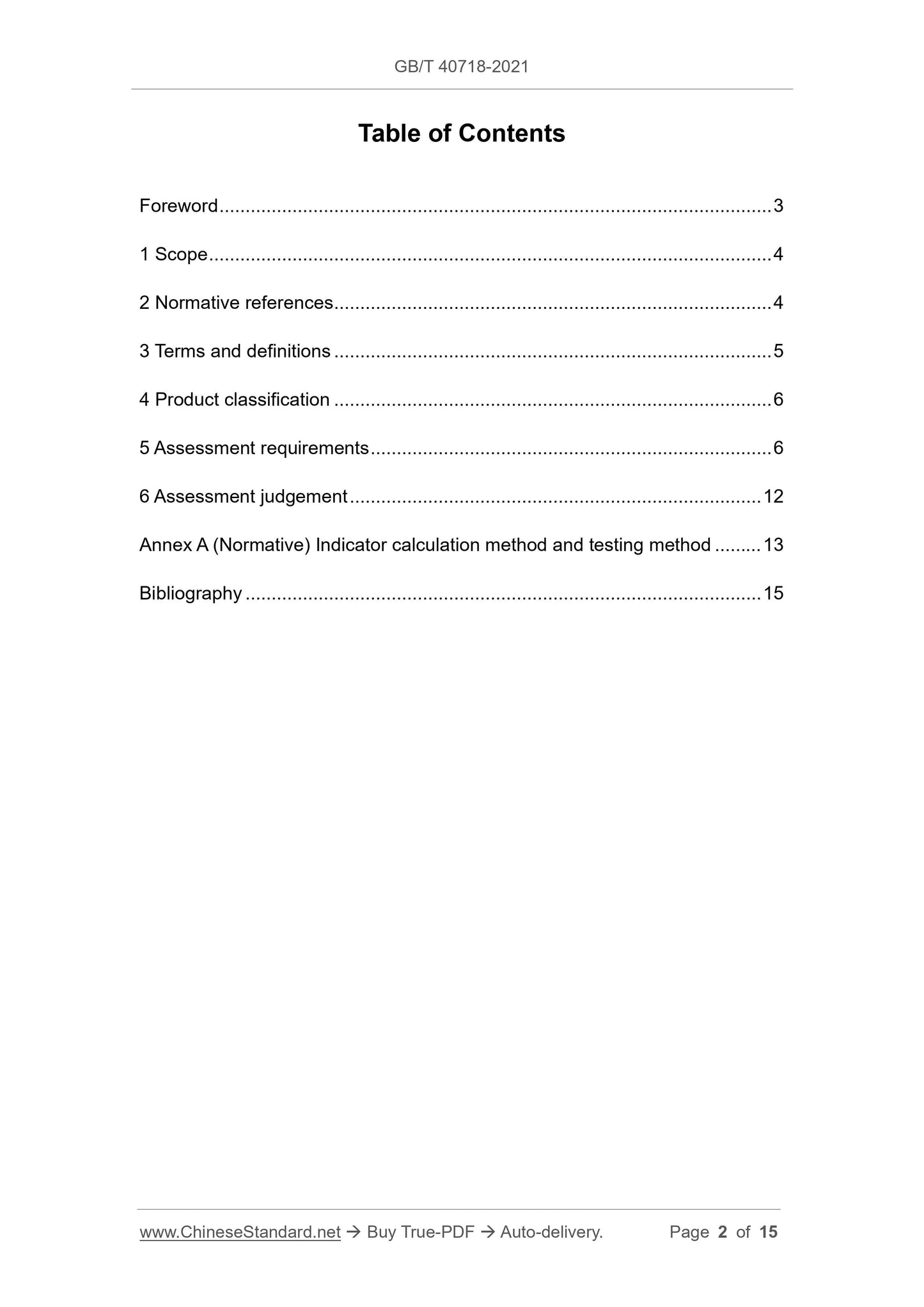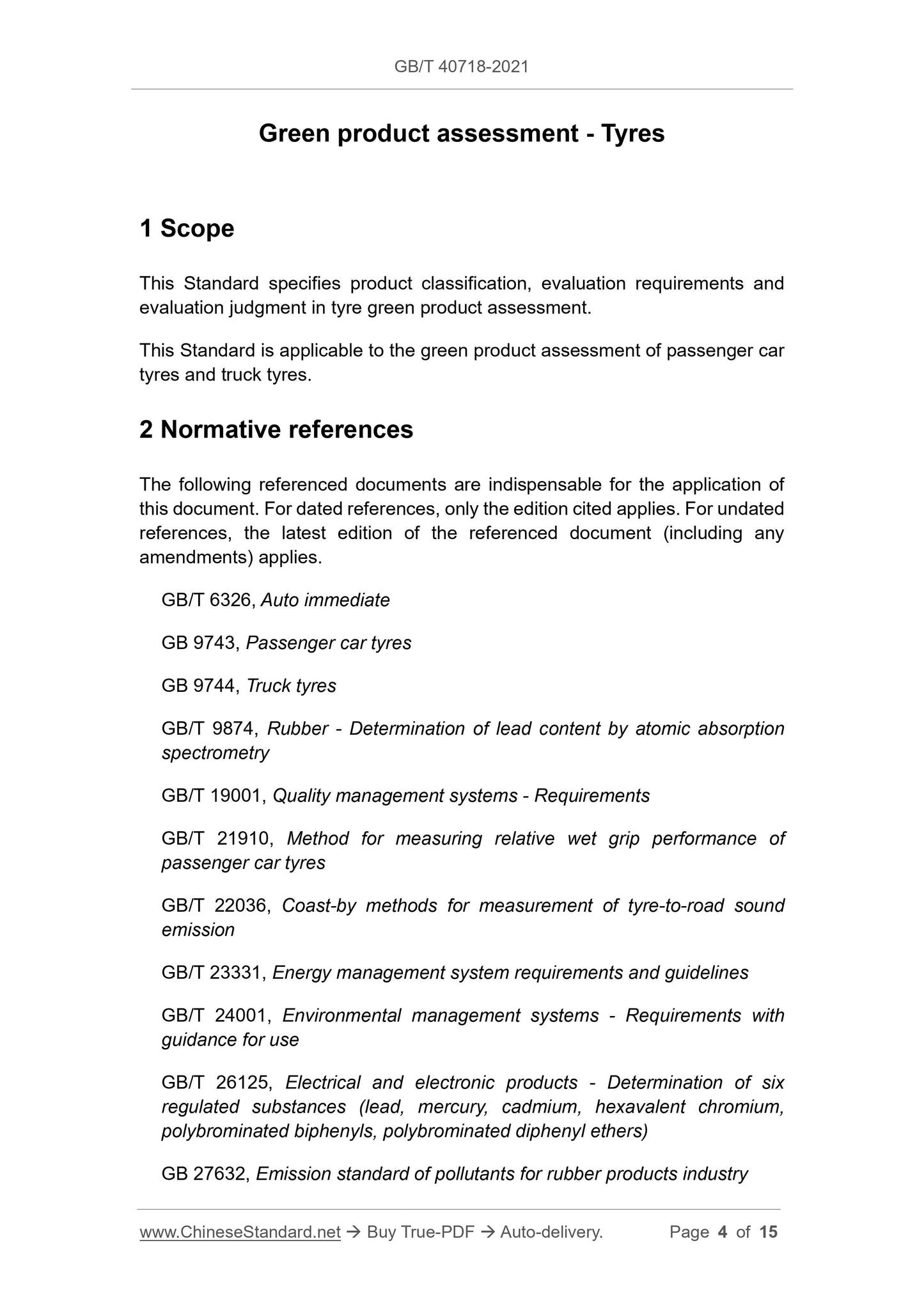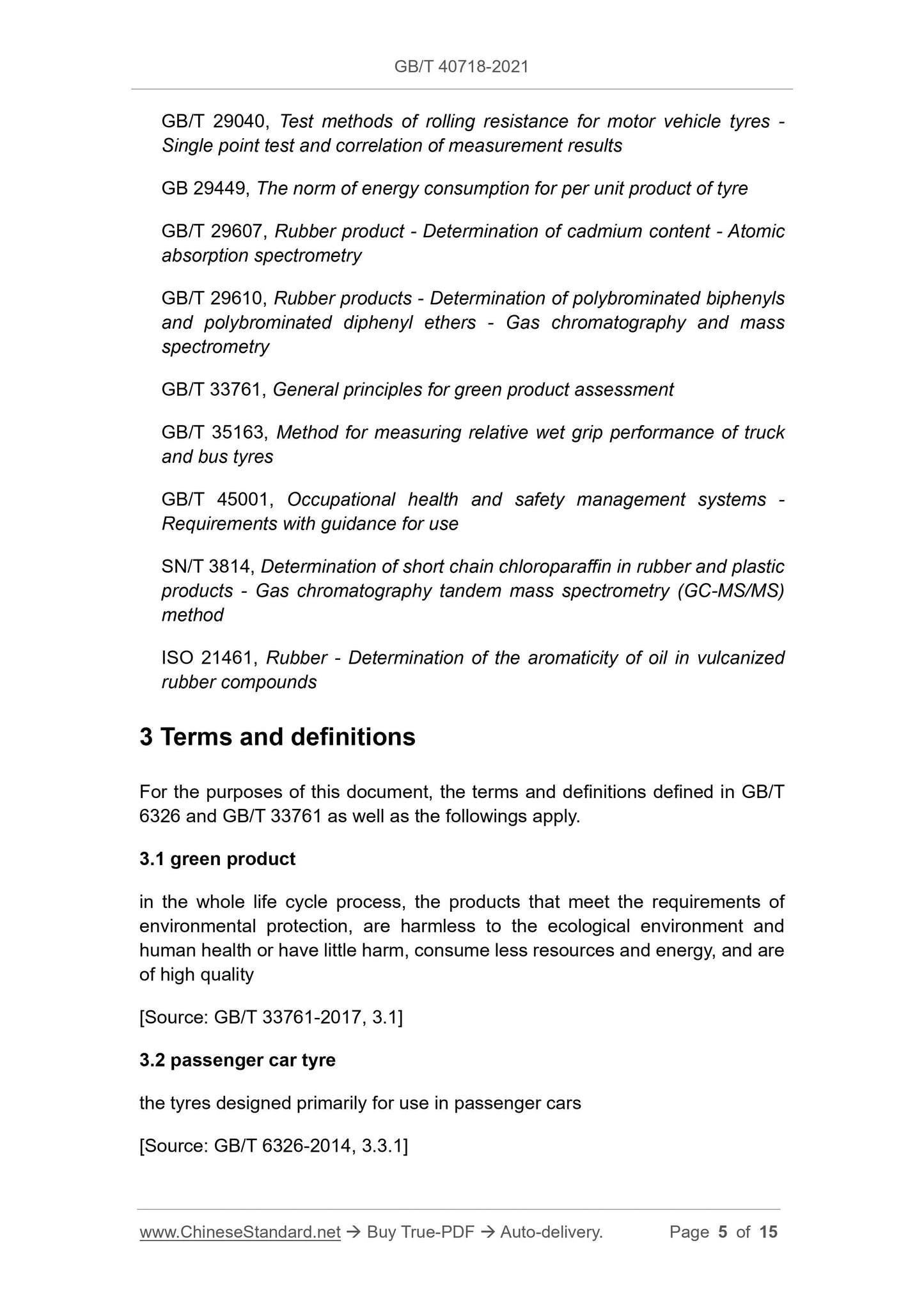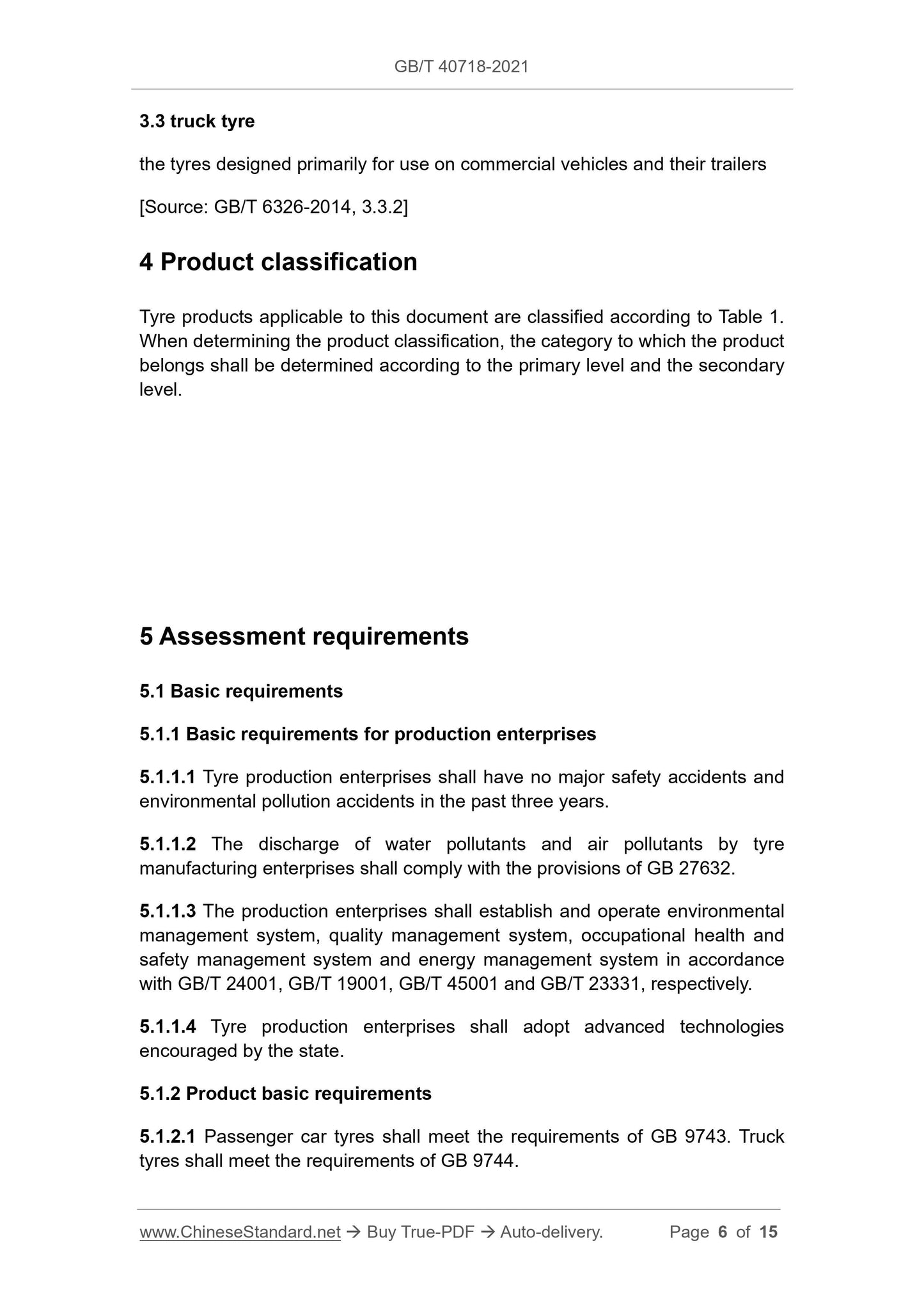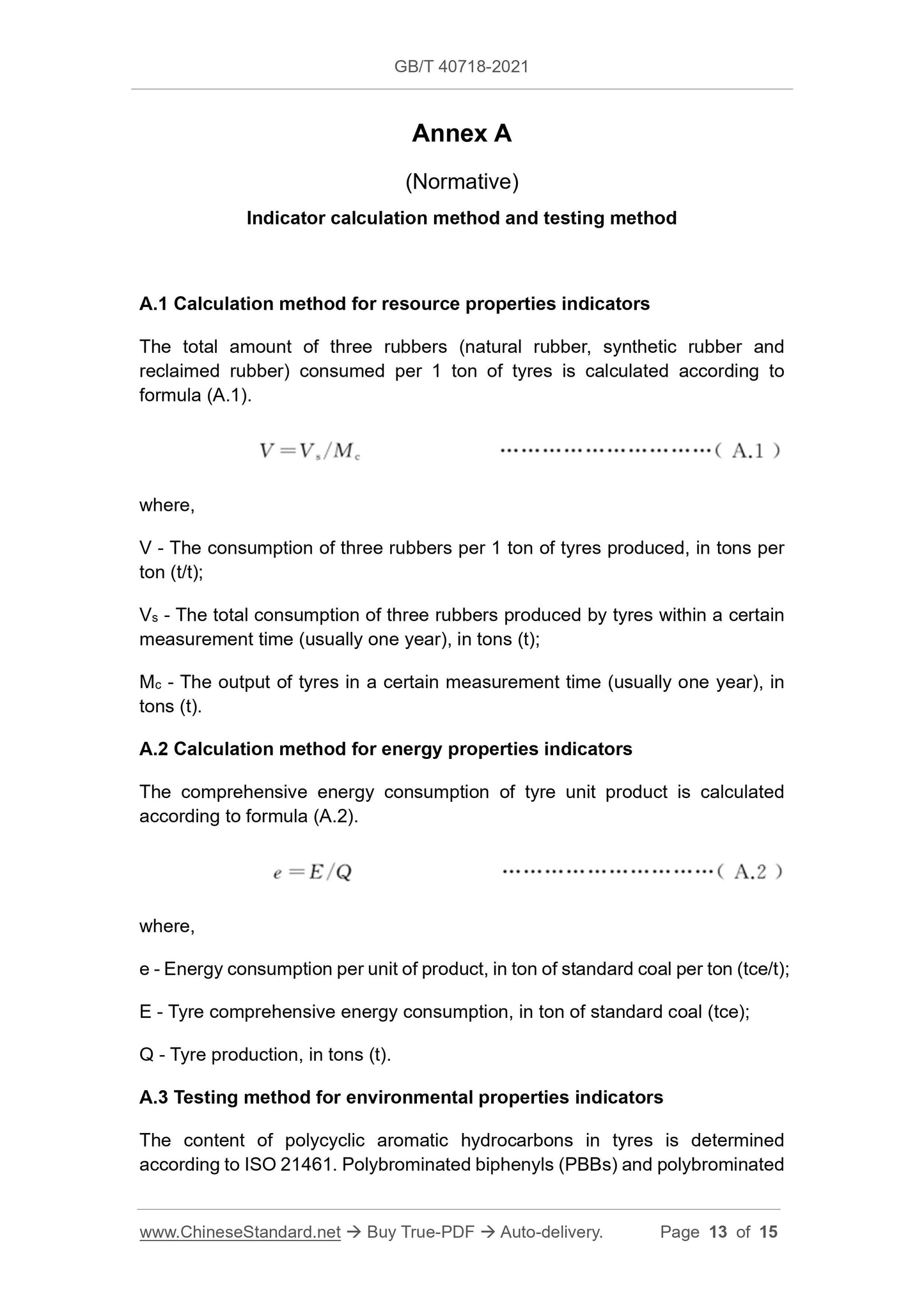1
/
of
6
www.ChineseStandard.us -- Field Test Asia Pte. Ltd.
GB/T 40718-2021 English PDF (GB/T40718-2021)
GB/T 40718-2021 English PDF (GB/T40718-2021)
Regular price
$170.00
Regular price
Sale price
$170.00
Unit price
/
per
Shipping calculated at checkout.
Couldn't load pickup availability
GB/T 40718-2021: Green product assessment - Tyres
Delivery: 9 seconds. Download (& Email) true-PDF + Invoice.
Get Quotation: Click GB/T 40718-2021 (Self-service in 1-minute)
Historical versions (Master-website): GB/T 40718-2021
Preview True-PDF (Reload/Scroll-down if blank)
GB/T 40718-2021
GB
NATIONAL STANDARD OF THE
PEOPLE’S REPUBLIC OF CHINA
ICS 83.160.01
CCS G 41
Green product assessment - Tyres
ISSUED ON: OCTOBER 11, 2021
IMPLEMENTED ON: MAY 01, 2022
Issued by: State Administration for Market Regulation;
Standardization Administration of the People's Republic of
China.
Table of Contents
Foreword ... 3
1 Scope ... 4
2 Normative references ... 4
3 Terms and definitions ... 5
4 Product classification ... 6
5 Assessment requirements ... 6
6 Assessment judgement ... 12
Annex A (Normative) Indicator calculation method and testing method ... 13
Bibliography ... 15
Green product assessment - Tyres
1 Scope
This Standard specifies product classification, evaluation requirements and
evaluation judgment in tyre green product assessment.
This Standard is applicable to the green product assessment of passenger car
tyres and truck tyres.
2 Normative references
The following referenced documents are indispensable for the application of
this document. For dated references, only the edition cited applies. For undated
references, the latest edition of the referenced document (including any
amendments) applies.
GB/T 6326, Auto immediate
GB 9743, Passenger car tyres
GB 9744, Truck tyres
GB/T 9874, Rubber - Determination of lead content by atomic absorption
spectrometry
GB/T 19001, Quality management systems - Requirements
GB/T 21910, Method for measuring relative wet grip performance of
passenger car tyres
GB/T 22036, Coast-by methods for measurement of tyre-to-road sound
emission
GB/T 23331, Energy management system requirements and guidelines
GB/T 24001, Environmental management systems - Requirements with
guidance for use
GB/T 26125, Electrical and electronic products - Determination of six
regulated substances (lead, mercury, cadmium, hexavalent chromium,
polybrominated biphenyls, polybrominated diphenyl ethers)
GB 27632, Emission standard of pollutants for rubber products industry
GB/T 29040, Test methods of rolling resistance for motor vehicle tyres -
Single point test and correlation of measurement results
GB 29449, The norm of energy consumption for per unit product of tyre
GB/T 29607, Rubber product - Determination of cadmium content - Atomic
absorption spectrometry
GB/T 29610, Rubber products - Determination of polybrominated biphenyls
and polybrominated diphenyl ethers - Gas chromatography and mass
spectrometry
GB/T 33761, General principles for green product assessment
GB/T 35163, Method for measuring relative wet grip performance of truck
and bus tyres
GB/T 45001, Occupational health and safety management systems -
Requirements with guidance for use
SN/T 3814, Determination of short chain chloroparaffin in rubber and plastic
products - Gas chromatography tandem mass spectrometry (GC-MS/MS)
method
ISO 21461, Rubber - Determination of the aromaticity of oil in vulcanized
rubber compounds
3 Terms and definitions
For the purposes of this document, the terms and definitions defined in GB/T
6326 and GB/T 33761 as well as the followings apply.
3.1 green product
in the whole life cycle process, the products that meet the requirements of
environmental protection, are harmless to the ecological environment and
human health or have little harm, consume less resources and energy, and are
of high quality
[Source: GB/T 33761-2017, 3.1]
3.2 passenger car tyre
the tyres designed primarily for use in passenger cars
[Source: GB/T 6326-2014, 3.3.1]
3.3 truck tyre
the tyres designed primarily for use on commercial vehicles and their trailers
[Source: GB/T 6326-2014, 3.3.2]
4 Product classification
Tyre products applicable to this document are classified according to Table 1.
When determining the product classification, the category to which the product
belongs shall be determined according to the primary level and the secondary
level.
5 Assessment requirements
5.1 Basic requirements
5.1.1 Basic requirements for production enterprises
5.1.1.1 Tyre production enterprises shall have no major safety accidents and
environmental pollution accidents in the past three years.
5.1.1.2 The discharge of water pollutants and air pollutants by tyre
manufacturing enterprises shall comply with the provisions of GB 27632.
5.1.1.3 The production enterprises shall establish and operate environmental
management system, quality management system, occupational health and
safety management system and energy management system in accordance
with GB/T 24001, GB/T 19001, GB/T 45001 and GB/T 23331, respectively.
5.1.1.4 Tyre production enterprises shall adopt advanced technologies
encouraged by the state.
5.1.2 Product basic requirements
5.1.2.1 Passenger car tyres shall meet the requirements of GB 9743. Truck
tyres shall meet the requirements of GB 9744.
Annex A
(Normative)
Indicator calculation method and testing method
A.1 Calculation method for resource properties indicators
The total amount of three rubbers (natural rubber, synthetic rubber and
reclaimed rubber) consumed per 1 ton of tyres is calculated according to
formula (A.1).
where,
V - The consumption of three rubbers per 1 ton of tyres produced, in tons per
ton (t/t);
Vs - The total consumption of three rubbers produced by tyres within a certain
measurement time (usually one year), in tons (t);
Mc - The output of tyres in a certain measurement time (usually one year), in
tons (t).
A.2 Calculation method for energy properties indicators
The comprehensive energy consumption of tyre unit product is calculated
according to formula (A.2).
where,
e - Energy consumption per unit of product, in ton of standard coal per ton (tce/t);
E - Tyre comprehensive energy consumption, in ton of standard coal (tce);
Q - Tyre production, in tons (t).
A.3 Testing method for environmental properties indicators
The content of polycyclic aromatic hydrocarbons in tyres is determined
according to ISO 21461. Polybrominated biphenyls (PBBs) and polybrominated
GB/T 40718-2021
GB
NATIONAL STANDARD OF THE
PEOPLE’S REPUBLIC OF CHINA
ICS 83.160.01
CCS G 41
Green product assessment - Tyres
ISSUED ON: OCTOBER 11, 2021
IMPLEMENTED ON: MAY 01, 2022
Issued by: State Administration for Market Regulation;
Standardization Administration of the People's Republic of
China.
Table of Contents
Foreword ... 3
1 Scope ... 4
2 Normative references ... 4
3 Terms and definitions ... 5
4 Product classification ... 6
5 Assessment requirements ... 6
6 Assessment judgement ... 12
Annex A (Normative) Indicator calculation method and testing method ... 13
Bibliography ... 15
Green product assessment - Tyres
1 Scope
This Standard specifies product classification, evaluation requirements and
evaluation judgment in tyre green product assessment.
This Standard is applicable to the green product assessment of passenger car
tyres and truck tyres.
2 Normative references
The following referenced documents are indispensable for the application of
this document. For dated references, only the edition cited applies. For undated
references, the latest edition of the referenced document (including any
amendments) applies.
GB/T 6326, Auto immediate
GB 9743, Passenger car tyres
GB 9744, Truck tyres
GB/T 9874, Rubber - Determination of lead content by atomic absorption
spectrometry
GB/T 19001, Quality management systems - Requirements
GB/T 21910, Method for measuring relative wet grip performance of
passenger car tyres
GB/T 22036, Coast-by methods for measurement of tyre-to-road sound
emission
GB/T 23331, Energy management system requirements and guidelines
GB/T 24001, Environmental management systems - Requirements with
guidance for use
GB/T 26125, Electrical and electronic products - Determination of six
regulated substances (lead, mercury, cadmium, hexavalent chromium,
polybrominated biphenyls, polybrominated diphenyl ethers)
GB 27632, Emission standard of pollutants for rubber products industry
GB/T 29040, Test methods of rolling resistance for motor vehicle tyres -
Single point test and correlation of measurement results
GB 29449, The norm of energy consumption for per unit product of tyre
GB/T 29607, Rubber product - Determination of cadmium content - Atomic
absorption spectrometry
GB/T 29610, Rubber products - Determination of polybrominated biphenyls
and polybrominated diphenyl ethers - Gas chromatography and mass
spectrometry
GB/T 33761, General principles for green product assessment
GB/T 35163, Method for measuring relative wet grip performance of truck
and bus tyres
GB/T 45001, Occupational health and safety management systems -
Requirements with guidance for use
SN/T 3814, Determination of short chain chloroparaffin in rubber and plastic
products - Gas chromatography tandem mass spectrometry (GC-MS/MS)
method
ISO 21461, Rubber - Determination of the aromaticity of oil in vulcanized
rubber compounds
3 Terms and definitions
For the purposes of this document, the terms and definitions defined in GB/T
6326 and GB/T 33761 as well as the followings apply.
3.1 green product
in the whole life cycle process, the products that meet the requirements of
environmental protection, are harmless to the ecological environment and
human health or have little harm, consume less resources and energy, and are
of high quality
[Source: GB/T 33761-2017, 3.1]
3.2 passenger car tyre
the tyres designed primarily for use in passenger cars
[Source: GB/T 6326-2014, 3.3.1]
3.3 truck tyre
the tyres designed primarily for use on commercial vehicles and their trailers
[Source: GB/T 6326-2014, 3.3.2]
4 Product classification
Tyre products applicable to this document are classified according to Table 1.
When determining the product classification, the category to which the product
belongs shall be determined according to the primary level and the secondary
level.
5 Assessment requirements
5.1 Basic requirements
5.1.1 Basic requirements for production enterprises
5.1.1.1 Tyre production enterprises shall have no major safety accidents and
environmental pollution accidents in the past three years.
5.1.1.2 The discharge of water pollutants and air pollutants by tyre
manufacturing enterprises shall comply with the provisions of GB 27632.
5.1.1.3 The production enterprises shall establish and operate environmental
management system, quality management system, occupational health and
safety management system and energy management system in accordance
with GB/T 24001, GB/T 19001, GB/T 45001 and GB/T 23331, respectively.
5.1.1.4 Tyre production enterprises shall adopt advanced technologies
encouraged by the state.
5.1.2 Product basic requirements
5.1.2.1 Passenger car tyres shall meet the requirements of GB 9743. Truck
tyres shall meet the requirements of GB 9744.
Annex A
(Normative)
Indicator calculation method and testing method
A.1 Calculation method for resource properties indicators
The total amount of three rubbers (natural rubber, synthetic rubber and
reclaimed rubber) consumed per 1 ton of tyres is calculated according to
formula (A.1).
where,
V - The consumption of three rubbers per 1 ton of tyres produced, in tons per
ton (t/t);
Vs - The total consumption of three rubbers produced by tyres within a certain
measurement time (usually one year), in tons (t);
Mc - The output of tyres in a certain measurement time (usually one year), in
tons (t).
A.2 Calculation method for energy properties indicators
The comprehensive energy consumption of tyre unit product is calculated
according to formula (A.2).
where,
e - Energy consumption per unit of product, in ton of standard coal per ton (tce/t);
E - Tyre comprehensive energy consumption, in ton of standard coal (tce);
Q - Tyre production, in tons (t).
A.3 Testing method for environmental properties indicators
The content of polycyclic aromatic hydrocarbons in tyres is determined
according to ISO 21461. Polybrominated biphenyls (PBBs) and polybrominated
Delivery: 9 seconds. Download (& Email) true-PDF + Invoice.
Get Quotation: Click GB/T 40718-2021 (Self-service in 1-minute)
Historical versions (Master-website): GB/T 40718-2021
Preview True-PDF (Reload/Scroll-down if blank)
GB/T 40718-2021
GB
NATIONAL STANDARD OF THE
PEOPLE’S REPUBLIC OF CHINA
ICS 83.160.01
CCS G 41
Green product assessment - Tyres
ISSUED ON: OCTOBER 11, 2021
IMPLEMENTED ON: MAY 01, 2022
Issued by: State Administration for Market Regulation;
Standardization Administration of the People's Republic of
China.
Table of Contents
Foreword ... 3
1 Scope ... 4
2 Normative references ... 4
3 Terms and definitions ... 5
4 Product classification ... 6
5 Assessment requirements ... 6
6 Assessment judgement ... 12
Annex A (Normative) Indicator calculation method and testing method ... 13
Bibliography ... 15
Green product assessment - Tyres
1 Scope
This Standard specifies product classification, evaluation requirements and
evaluation judgment in tyre green product assessment.
This Standard is applicable to the green product assessment of passenger car
tyres and truck tyres.
2 Normative references
The following referenced documents are indispensable for the application of
this document. For dated references, only the edition cited applies. For undated
references, the latest edition of the referenced document (including any
amendments) applies.
GB/T 6326, Auto immediate
GB 9743, Passenger car tyres
GB 9744, Truck tyres
GB/T 9874, Rubber - Determination of lead content by atomic absorption
spectrometry
GB/T 19001, Quality management systems - Requirements
GB/T 21910, Method for measuring relative wet grip performance of
passenger car tyres
GB/T 22036, Coast-by methods for measurement of tyre-to-road sound
emission
GB/T 23331, Energy management system requirements and guidelines
GB/T 24001, Environmental management systems - Requirements with
guidance for use
GB/T 26125, Electrical and electronic products - Determination of six
regulated substances (lead, mercury, cadmium, hexavalent chromium,
polybrominated biphenyls, polybrominated diphenyl ethers)
GB 27632, Emission standard of pollutants for rubber products industry
GB/T 29040, Test methods of rolling resistance for motor vehicle tyres -
Single point test and correlation of measurement results
GB 29449, The norm of energy consumption for per unit product of tyre
GB/T 29607, Rubber product - Determination of cadmium content - Atomic
absorption spectrometry
GB/T 29610, Rubber products - Determination of polybrominated biphenyls
and polybrominated diphenyl ethers - Gas chromatography and mass
spectrometry
GB/T 33761, General principles for green product assessment
GB/T 35163, Method for measuring relative wet grip performance of truck
and bus tyres
GB/T 45001, Occupational health and safety management systems -
Requirements with guidance for use
SN/T 3814, Determination of short chain chloroparaffin in rubber and plastic
products - Gas chromatography tandem mass spectrometry (GC-MS/MS)
method
ISO 21461, Rubber - Determination of the aromaticity of oil in vulcanized
rubber compounds
3 Terms and definitions
For the purposes of this document, the terms and definitions defined in GB/T
6326 and GB/T 33761 as well as the followings apply.
3.1 green product
in the whole life cycle process, the products that meet the requirements of
environmental protection, are harmless to the ecological environment and
human health or have little harm, consume less resources and energy, and are
of high quality
[Source: GB/T 33761-2017, 3.1]
3.2 passenger car tyre
the tyres designed primarily for use in passenger cars
[Source: GB/T 6326-2014, 3.3.1]
3.3 truck tyre
the tyres designed primarily for use on commercial vehicles and their trailers
[Source: GB/T 6326-2014, 3.3.2]
4 Product classification
Tyre products applicable to this document are classified according to Table 1.
When determining the product classification, the category to which the product
belongs shall be determined according to the primary level and the secondary
level.
5 Assessment requirements
5.1 Basic requirements
5.1.1 Basic requirements for production enterprises
5.1.1.1 Tyre production enterprises shall have no major safety accidents and
environmental pollution accidents in the past three years.
5.1.1.2 The discharge of water pollutants and air pollutants by tyre
manufacturing enterprises shall comply with the provisions of GB 27632.
5.1.1.3 The production enterprises shall establish and operate environmental
management system, quality management system, occupational health and
safety management system and energy management system in accordance
with GB/T 24001, GB/T 19001, GB/T 45001 and GB/T 23331, respectively.
5.1.1.4 Tyre production enterprises shall adopt advanced technologies
encouraged by the state.
5.1.2 Product basic requirements
5.1.2.1 Passenger car tyres shall meet the requirements of GB 9743. Truck
tyres shall meet the requirements of GB 9744.
Annex A
(Normative)
Indicator calculation method and testing method
A.1 Calculation method for resource properties indicators
The total amount of three rubbers (natural rubber, synthetic rubber and
reclaimed rubber) consumed per 1 ton of tyres is calculated according to
formula (A.1).
where,
V - The consumption of three rubbers per 1 ton of tyres produced, in tons per
ton (t/t);
Vs - The total consumption of three rubbers produced by tyres within a certain
measurement time (usually one year), in tons (t);
Mc - The output of tyres in a certain measurement time (usually one year), in
tons (t).
A.2 Calculation method for energy properties indicators
The comprehensive energy consumption of tyre unit product is calculated
according to formula (A.2).
where,
e - Energy consumption per unit of product, in ton of standard coal per ton (tce/t);
E - Tyre comprehensive energy consumption, in ton of standard coal (tce);
Q - Tyre production, in tons (t).
A.3 Testing method for environmental properties indicators
The content of polycyclic aromatic hydrocarbons in tyres is determined
according to ISO 21461. Polybrominated biphenyls (PBBs) and polybrominated
GB/T 40718-2021
GB
NATIONAL STANDARD OF THE
PEOPLE’S REPUBLIC OF CHINA
ICS 83.160.01
CCS G 41
Green product assessment - Tyres
ISSUED ON: OCTOBER 11, 2021
IMPLEMENTED ON: MAY 01, 2022
Issued by: State Administration for Market Regulation;
Standardization Administration of the People's Republic of
China.
Table of Contents
Foreword ... 3
1 Scope ... 4
2 Normative references ... 4
3 Terms and definitions ... 5
4 Product classification ... 6
5 Assessment requirements ... 6
6 Assessment judgement ... 12
Annex A (Normative) Indicator calculation method and testing method ... 13
Bibliography ... 15
Green product assessment - Tyres
1 Scope
This Standard specifies product classification, evaluation requirements and
evaluation judgment in tyre green product assessment.
This Standard is applicable to the green product assessment of passenger car
tyres and truck tyres.
2 Normative references
The following referenced documents are indispensable for the application of
this document. For dated references, only the edition cited applies. For undated
references, the latest edition of the referenced document (including any
amendments) applies.
GB/T 6326, Auto immediate
GB 9743, Passenger car tyres
GB 9744, Truck tyres
GB/T 9874, Rubber - Determination of lead content by atomic absorption
spectrometry
GB/T 19001, Quality management systems - Requirements
GB/T 21910, Method for measuring relative wet grip performance of
passenger car tyres
GB/T 22036, Coast-by methods for measurement of tyre-to-road sound
emission
GB/T 23331, Energy management system requirements and guidelines
GB/T 24001, Environmental management systems - Requirements with
guidance for use
GB/T 26125, Electrical and electronic products - Determination of six
regulated substances (lead, mercury, cadmium, hexavalent chromium,
polybrominated biphenyls, polybrominated diphenyl ethers)
GB 27632, Emission standard of pollutants for rubber products industry
GB/T 29040, Test methods of rolling resistance for motor vehicle tyres -
Single point test and correlation of measurement results
GB 29449, The norm of energy consumption for per unit product of tyre
GB/T 29607, Rubber product - Determination of cadmium content - Atomic
absorption spectrometry
GB/T 29610, Rubber products - Determination of polybrominated biphenyls
and polybrominated diphenyl ethers - Gas chromatography and mass
spectrometry
GB/T 33761, General principles for green product assessment
GB/T 35163, Method for measuring relative wet grip performance of truck
and bus tyres
GB/T 45001, Occupational health and safety management systems -
Requirements with guidance for use
SN/T 3814, Determination of short chain chloroparaffin in rubber and plastic
products - Gas chromatography tandem mass spectrometry (GC-MS/MS)
method
ISO 21461, Rubber - Determination of the aromaticity of oil in vulcanized
rubber compounds
3 Terms and definitions
For the purposes of this document, the terms and definitions defined in GB/T
6326 and GB/T 33761 as well as the followings apply.
3.1 green product
in the whole life cycle process, the products that meet the requirements of
environmental protection, are harmless to the ecological environment and
human health or have little harm, consume less resources and energy, and are
of high quality
[Source: GB/T 33761-2017, 3.1]
3.2 passenger car tyre
the tyres designed primarily for use in passenger cars
[Source: GB/T 6326-2014, 3.3.1]
3.3 truck tyre
the tyres designed primarily for use on commercial vehicles and their trailers
[Source: GB/T 6326-2014, 3.3.2]
4 Product classification
Tyre products applicable to this document are classified according to Table 1.
When determining the product classification, the category to which the product
belongs shall be determined according to the primary level and the secondary
level.
5 Assessment requirements
5.1 Basic requirements
5.1.1 Basic requirements for production enterprises
5.1.1.1 Tyre production enterprises shall have no major safety accidents and
environmental pollution accidents in the past three years.
5.1.1.2 The discharge of water pollutants and air pollutants by tyre
manufacturing enterprises shall comply with the provisions of GB 27632.
5.1.1.3 The production enterprises shall establish and operate environmental
management system, quality management system, occupational health and
safety management system and energy management system in accordance
with GB/T 24001, GB/T 19001, GB/T 45001 and GB/T 23331, respectively.
5.1.1.4 Tyre production enterprises shall adopt advanced technologies
encouraged by the state.
5.1.2 Product basic requirements
5.1.2.1 Passenger car tyres shall meet the requirements of GB 9743. Truck
tyres shall meet the requirements of GB 9744.
Annex A
(Normative)
Indicator calculation method and testing method
A.1 Calculation method for resource properties indicators
The total amount of three rubbers (natural rubber, synthetic rubber and
reclaimed rubber) consumed per 1 ton of tyres is calculated according to
formula (A.1).
where,
V - The consumption of three rubbers per 1 ton of tyres produced, in tons per
ton (t/t);
Vs - The total consumption of three rubbers produced by tyres within a certain
measurement time (usually one year), in tons (t);
Mc - The output of tyres in a certain measurement time (usually one year), in
tons (t).
A.2 Calculation method for energy properties indicators
The comprehensive energy consumption of tyre unit product is calculated
according to formula (A.2).
where,
e - Energy consumption per unit of product, in ton of standard coal per ton (tce/t);
E - Tyre comprehensive energy consumption, in ton of standard coal (tce);
Q - Tyre production, in tons (t).
A.3 Testing method for environmental properties indicators
The content of polycyclic aromatic hydrocarbons in tyres is determined
according to ISO 21461. Polybrominated biphenyls (PBBs) and polybrominated
Share
